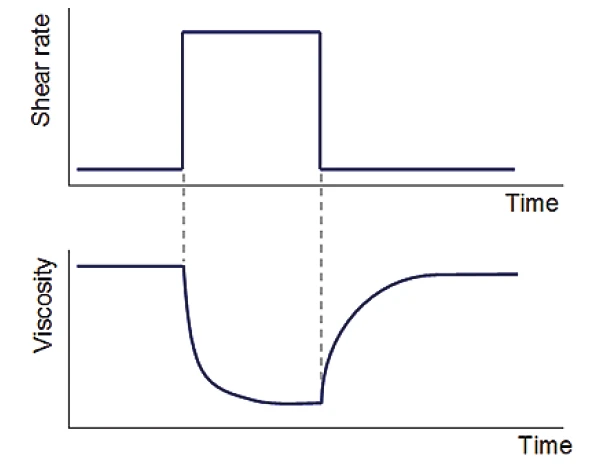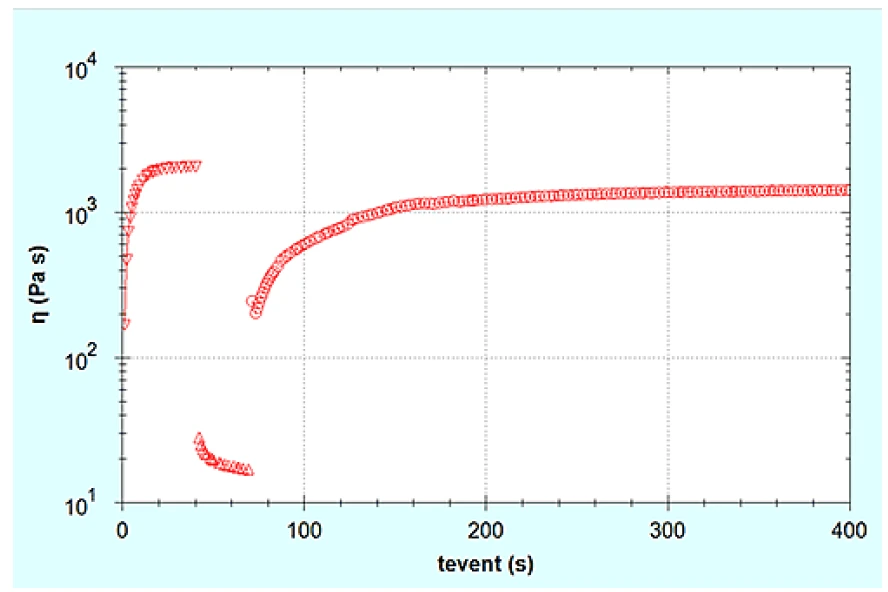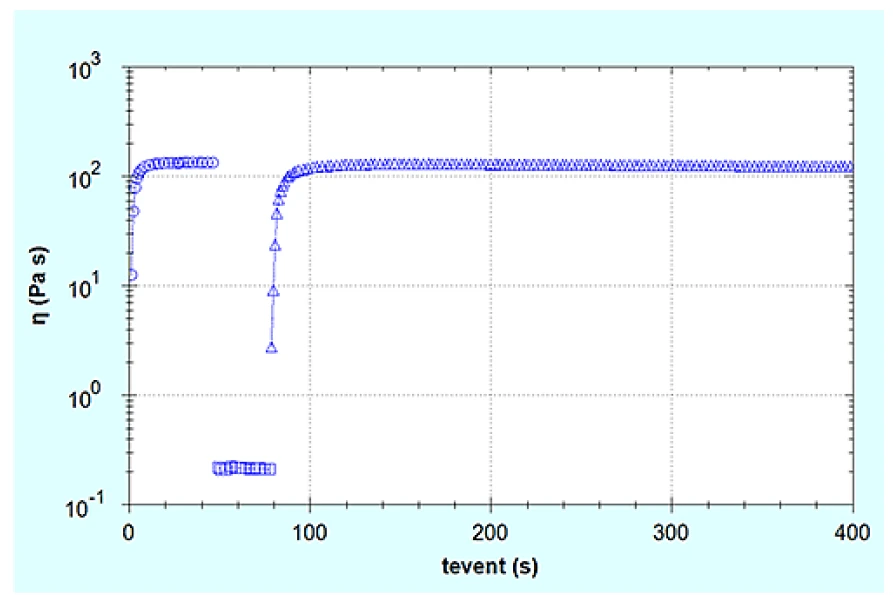Introduction
Many consumer products are packaged in tubes or bottles where product application involves pumping the product through a nozzle. Such products tend to be Shear ThinningThe most common type of non-Newtonian behavior is shear thinning or pseudoplastic flow, where the fluid viscosity decreases with increasing shear.shear-thinning products where the viscosity drops during the extrusion process due to the increasing shear rate, and then recovers on exiting the orifice as the shear rate is reduced. The shear rate encountered during this process is related to the radius, r of the orifice and the volumetric flow rate Q by the following expression:

The parameter n is the power law index, which is 1 for a Newtonian liquid and between 0 and 1 for a Non-NewtonianA non-Newtonian fluid is one that exhibits a viscosity that varies as a function of the applied shear rate or shear stress.non-Newtonian fluid. This value can be readily attained from a variable shear rate test by fitting a Power Law ModelThe power law model is a common rheological model to quantify (typically) the shear thinning nature of a sample, with the value closer to zero indicating a more shear thinning material.power law model to the resultant data.
By measuring the volumetric flow rate (volume dispensed in given time) and the internal radius of the orifice, it is possible to estimate the shear rate encountered during the extrusion process. This value can be inputted into a step shear rate test (Figure 1) which shears the sample at a low shear rate for a given time (prior to extrusion) before stepping up to the shear rate of interest. Viscosity recovery is then followed as the shear rate is dropped to its initial value. This test demonstrates how fast the sample recovers its viscosity following the extrusion process and indicates the thickness or viscosity of the product at time of use.
Thixotropic properties can be quantified by measuring the final viscosity at the end of the first stage and the time it takes for a defined percentage of that viscosity to be recovered during the final stage of the test. This value can be used for comparing between products or formulations and is applicable across a wide range of industries and applications.

Experimental
- The viscosity recovery properties of toothpaste and a body lotion were evaluated under shear rate conditions associated with product extrusion during use.
- Rotational rheometer measurements were made using a Kinexus rotational rheometer with a Peltier plate cartridge and a roughened parallel plate measuring system1, and using standard pre-configured sequences in the rSpace software.
- A standard loading sequence was used to ensure that both samples were subject to a consistent and controllable loading protocol.
- All rheology measurements were performed at 25°C.
- The relevant extrusion shear rates were automatically calculated as part of the test sequence using inputted values of extruded volume, extrusion time and aperture radius. The test was programmed to use this calculated value as the intermediate shear rate in a step shear rate test with step 1 and step 2 employing a constant shear rate of 0.1s-1.
- The time to recover 90% of the products original viscosity was automatically determined and reported at the end of the test.
Results and Discussion
The automatic calculator evaluated the shear rate for extrusion for product delivery to be 34 s-1 for the toothpaste and 840 s-1 for the body lotion. These values were used in the intermediate stage of the test.
Figure 2 shows the results for the toothpaste. Clearly this is a highly thixotropic material since it does not fully recover its structure in the timescale of the test, reaching only 70% of its original viscosity and taking approximately 6 minutes to attain this level of recovery.
In contrast, the body lotion shown in Figure 3 recovers almost all of its original viscosity taking only 7 seconds to attain the same percentage recovery as the toothpaste and 23 seconds to attain 90% recovery. This material would be classed as essentially non-thixotropic in comparison.
In consumer terms, this would imply that the body lotion would restructure very quickly after coming in contact with the skin, which may prevent excessive spreading or potential dripping. The toothpaste would have a lower viscosity on the brush prior to brushing which should make it easier to distribute in the mouth and perhaps affect sensory properties. It is important, however, that the viscosity is not so low that the product can flow through the bristles or sag on the brush.


Conclusion
A three-step shear rate test was performed on a toothpaste and body lotion to evaluate the extent of viscosity recovery following extrusion from a tube and bottle respectively. The toothpaste was shown to be highly thixotropic taking 6 minutes to recover 70% of its original viscosity. The body lotion attained the same degree of recovery in just 7 seconds and can be considered non-thixotropic in comparison
1Please note...
that testing is recommended to be undertaken with cone and plate or parallel plate geometry – with the latter being preferred for dispersions and emulsions with large particle sizes. Such material types may also require the use of serrated or roughened geometries to avoid artefacts relating to slippage at the geometry surface.